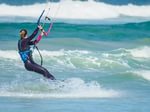South Carolina is blessed with miles of beautiful beaches, and people find a myriad of ways to enjoy their splendor. Some use a beach bivouac, where golf cart, loads of towels, tents, coolers, chairs, and other “necessary” accoutrements are strategically deployed. Others may prefer a simpler setup with just a towel and a book stuffed into a tote with some sunscreen. Off on the horizon, the kiteboarders and windsurfers go streaking atop the water past the colorful collage of tents and towels.
“When you sail, you can go wherever you want to go,” says Tucker Laffitte. “When you wakeboard, you can do whatever you want to do. And when you kiteboard, it’s like putting it all together. You’re totally free, it’s quiet, and you are out in the open ocean or on a lake somewhere. It’s like being one with nature, and that’s pretty cool.”
He started kiteboarding more than 12 years ago with his father, Tuck, and younger brother, Norris. Tucker and Norris became interested after seeing footage of kiteboarders while browsing around Half Moon Outfitters with their father. “We were watching that video about the sport, and I just became obsessed with the idea. My dad thought it looked bizarre, but I just started dreaming about doing it,” Norris says.
In 2005, while the sport was still gaining traction and interest was spreading from the West Coast, Tuck took his boys to Charleston for lessons. They studied at Air Kiteboarding with Davey Blair, one of the top professionals produced by the Palmetto State. Very few enthusiasts were located in the South Carolina area, and improvements in equipment were still being developed to meet the growing demands. “The first few times we went out, it was several miles of being dragged downwind to even learn how to stand up on the board. It was like being on a sailboat when you can’t furl the sail,” Norris admits.
In addition to their first lessons with Air Kiteboarding, the Laffittes spent time at Fripp Island, where they were able to apply what they had learned from the classes. “Fripp was an absolute perfect place to learn. The easiest place to first practice this sport is in about waist-deep water; it’s deep enough you’re not going to hurt yourself, but it’s also shallow enough for you to stand up and collect all your gear after you’ve fallen and made what we call ‘yard sales,’ which is when you lose all your gear and have to go back and collect it,” Norris says jokingly.
Tucker packed his kite up for a while during his undergraduate studies, but when he saw his brother getting better, he didn’t want to be bested by him. While at medical school in Charleston, it was easy for Tucker to get out on the water, and kiteboarding provided him much needed respite from the rigorous curriculum. Nevertheless, his younger sibling seems to maintain a slight lead in their amicable rivalry. “Norris still has some tricks I can’t do,” Tucker says.
The Laffittes have also entered the competitive arena, putting their kiteboarding knowledge, skills, and abilities to the ultimate test. The Fort 2 Battery race in Charleston starts at Fort Sumter and ends at the Charleston Battery. Boats and kiteboarders are able to race, and the Laffittes have made an impressive showing in the competition.
“It’s a fun time to get back together with the Charleston kiteboarding crew, and it’s becoming an annual event for us,” Norris says. “The racing element of the sport really caters to a broader age range of people, so I can see myself doing it for the rest of my life.”
Tucker adds, “It’s something I can do with my brother and my dad while being outside and getting some good exercise. It’s a passion for us.”

Though windsurfing is still enjoyed by watersports enthusiasts, kiteboarding is exploding in popularity on the South Carolina coast.
Columbia-native Francis Neuffer, M.D., took up windsurfing during his medical school residency as a way to blow off steam. Since Columbia is relatively close to the beach and he had previous experience with a Sunfish sailboat, he was drawn to windsurfing’s accessibility and simplicity compared to the sailboat. The windsurfing board consists basically of a paddleboard with a rudder and a huge sail, with the windsurfer holding the bar across the width of the main sheet and riding it like a surfboard.
Additionally, Francis admits a lazy day at the beach simply is not his idea of entertainment. “Windsurfing is something to actually ‘do’ at the beach instead of just lying around in the sun. Laying out never struck me as being much fun,” he says.
Windsurfers can achieve relatively remarkable speeds once they reach a certain level of experience. “It’s the closest thing to flying I’ve experienced while still being close to the surface of the Earth. I remember in the Outer Banks I was able to keep up with a pelican flying next to me,” Francis recalls.
Though windsurfing is still enjoyed by watersports enthusiasts, kiteboarding is exploding in popularity. Of the two sports, kiteboarding bears a lower cost of entry and a bit more of a thrill-seeking status. “Windsurfing is like downhill snow skiing,” Francis says, “and kiteboarding is like snowboarding.” Aerial tricks are more easily performed and offer kiteboarders a rush of energy along with an element of risk not present in windsurfing.
Kiteboarders glide along the water with their feet attached to their boards while a giant kite soars above them, harnessing enough wind power to tow them along the sea surface at rapid speed. The sport has recently been popularized in the United States, but some of the earliest recorded instances of using kites as a form of propulsion date back to 13th century China. The sport of kiteboarding as it is known today was first popularized during the 1980s in Breton, France, by the Legaignoux brothers, Dominique and Bruno. In 1985, they demonstrated their prototype at the Brest International Speed Week and filed their first patent.
The father and son duo of Bill and Cory Roeseler of Oregon also played an important role in the history of the sport. Bill, who worked for several years as an aerodynamicist for Boeing, with his son, Cory, developed and patented the first commercially available kiteboarding rig called the KiteSki in 1994. By 1998, Joe Keuhl organized the first kiteboarding event where the world’s premier kiteboarders — all 25 of them — held their first gathering off the coast of Maui, Hawaii.
Kiteboarding was very treacherous in the late 1990s due to the shortage of qualified instruction as well as the lack of any novice-level equipment. The early kiteboarders purchased what was available and learned by trial and error how to use their equipment to perform impressive aerial stunts. Kiteboarders attach the kite to their bodies by way of a harness. A control bar allows them to steer and control the kite while they skim across the top of the water on their board. Different sized kites and boards offer them different levels of speed and control to perform aerial tricks such as handle passes (passing the handle behind the back while in the air), rolls, and twists.
Tom Austin joined the growing ranks of kiteboarders about two years ago. He observed the sport during a weekend trip to Isle of Palms and became intrigued. Tom grew up wakeboarding and waterskiing on Lake Wateree and saw some similarities between those sports and kiteboarding. He and his brother-in-law, John Powell, signed up for lessons at FORCE Kite and Wake in Mount Pleasant. Tom knew the sport had some inherent dangers and wanted to receive proper training. “I went there because they make you attend safety training to receive lessons or even rent equipment, and I thought that was a good idea because this sport can be dangerous if you don’t know what you’re doing,” Tom says.
After two years of being involved in the sport, Tom most enjoys the camaraderie of his brother-in-law and the fact that the sport is not as physically taxing as waterskiing. “It’s been a great way for me to spend time with John, and it doesn’t wear me down like waterskiing. Being pulled around by a motorboat is physically exhausting, whereas the kite lifts you up and out, so it definitely feels better,” Tom explains. He mostly kiteboards down around Sullivan’s Island but recently went to St. Lucia, where he was pleasantly surprised to be the only kiteboarder in the area.
“I was the only person kiteboarding down there, and it was awesome!” Tom says. “Overcrowding can definitely be a problem where there might be 40 to 50 people down at Sullivan’s Island. I had St. Lucia to myself.”
Kiteboarding and windsurfing are not synonymous. Nevertheless, with kiteboarding having gone viral since the 1990s, the Olympic Committee almost replaced windsurfing with kiteboarding at the 2016 Summer Games in Rio. The delegate from Spain embarrassingly admitted when he cast his vote that he did not understand the difference between the two sports because of the language barrier; the nuances of the sports were lost in translation.
With most of the Earth’s surface covered by water, enough room is surely available for both of these sports — as long as their participants don’t all decide to congregate off Sullivan’s Island at the same time.





Recent Comments